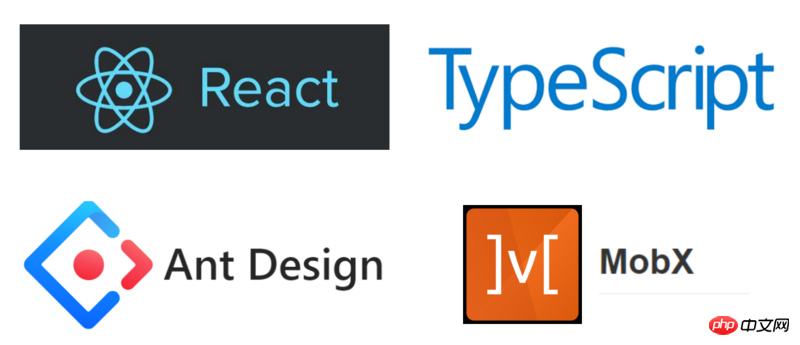Rumah >hujung hadapan web >tutorial js >React结合TypeScript和Mobx步骤详解
React结合TypeScript和Mobx步骤详解
- php中世界最好的语言asal
- 2018-05-24 10:53:207378semak imbas
这次给大家带来React结合TypeScript和Mobx步骤详解,React结合TypeScript和Mobx的注意事项有哪些,下面就是实战案例,一起来看一下。

为什么要使用TypeScript
侦测错误
通过静态类型检测可以尽早检测出程序中隐藏的的逻辑错误,对于JavaScript动态的弱类型语言,虽然灵活性高,但是对于初学者来说,如果不熟悉JavaScript内部的语言机制,很容易造成隐藏的事故。但是通过TypeScript的静态类型检测可以规避这些问题,因为其能够约束变量产生的类型。结合IDE编辑器可以推导变量对应的类型以及内部的结构,提高代码的健壮性和可维护性。
抽象
类型系统能够强化规范编程,TypeScript提供定义接口。在开发大型复杂的应用软件时十分重要,一个系统模块可以抽象的看做一个TypeScript定义的接口。让设计脱离实现,最终体现出一种 IDL(接口定义语言,Interface Define Language),让程序设计回归本质。
文档
TypeScript可以自动根据类型标注生成文档,对于简单的功能实现都不需要编写注释。
为什么要使用Mobx
MobX 和 Redux 的比较
先要明白 mobx 和 redux 的定位是不同的。redux 管理的是 (STORE -> VIEW -> ACTION) 的整个闭环,而 mobx 只关心 STORE -> VIEW 的部分。
Redux优缺点:
数据流流动很自然,因为任何 dispatch 都会触发广播,依据对象引用是否变化来控制更新粒度。
通过充分利用时间回溯的特征,可以增强业务的可预测性与错误定位能力。
时间回溯代价高,因为每次都要更新引用,除非增加代码复杂度,或使用 immutable。
时间回溯的另一个代价是 action 与 reducer 完全脱节,原因是可回溯必然不能保证引用关系。
引入中间件,解决异步带来的副作用,业务逻辑或多或少参杂着 magic。
灵活利用中间件,可以通过约定完成许多复杂的工作。
对 typescript 支持困难。
Mobx优缺点:
数据流流动不自然,只有用到的数据才会引发绑定,局部精确更新,但避免了粒度控制烦恼。
没有时间回溯能力,因为数据只有一份引用。自始至终一份引用,不需要 immutable,也没有复制对象的额外开销。
数据流动由函数调用一气呵成,便于调试。
业务开发不是脑力活,而是体力活,少一些 magic,多一些效率。
由于没有 magic,所以没有中间件机制,没法通过 magic 加快工作效率(这里 magic 是指 action 分发到 reducer 的过程)。
完美支持 typescript。
SO: 前端数据流不太复杂的情况,使用 Mobx,因为更加清晰,也便于维护;如果前端数据流极度复杂,建议谨慎使用 Redux,通过中间件减缓巨大业务复杂度
使用Create-React-App来建立TypeScript的环境
npm i -g create-react-app create-react-app tinylog-ui --scripts-version=react-scripts-ts cd tinylog-ui/ npm start npm run eject
TPS: 最后一个命令使用eject将所有内建的配置暴露出来
通过create-react-app可以很方便地对整个项目完成环境初始化,如果愿意折腾TypeScript和webpack的环境可以试试,这里忽略webpack和TypeScript的环境搭建过程,而是使用create-react-app来实现环境搭建。
加入React-Router
单页应用怎么可以没有前端路由呢,所以我们要加入React-Rotuer, 这里使用的React-Router的版本是v4.2.0
路由配置使用姿势
对于React-Router,这里使用到的模块有Router, Route, Switch
React Router 是建立在 history 之上的。 简而言之,一个 history 知道如何去监听浏览器地址栏的变化, 并解析这个 URL 转化为 location 对象, 然后 router 使用它匹配到路由,最后正确地渲染对应的组件。
代码如下:
import * as React from 'react';
import * as ReactDOM from 'react-dom';
import { Router, Route, Switch } from 'react-router';
import { createBrowserHistory } from 'history';
import registerServiceWorker from './registerServiceWorker';
import { Root } from './containers/Root';
import './index.css';
import Container from './containers/Container';
import SignIn from './containers/Auth/signIn';
import SignUp from './containers/Auth/signUp';
const history = createBrowserHistory();
ReactDOM.render(
<Root>
<Router history={history}>
<Switch>
<Route
path="/signIn"
component={SignIn}
/>
<Route
path="/signUp"
component={SignUp}
/>
<Route
path="/"
component={Container}
/>
</Switch>
</Router>
</Root>,
document.getElementById('root') as HTMLElement
);
registerServiceWorker();
页面的编写
这里描述一写Container这个组件的编写
import * as React from 'react';
import Header from '../../layout/Header';
import { IAuth } from '../../interfaces';
import { Route, Switch } from 'react-router';
import App from '../App';
import Website from '../Website';
// 这部分是坑点,一开始不知道配置,后发现react-rotuer的4.0版本下需要配置prop的接口
interface Container extends RouteComponentProps<{}> {
}
class Container extends React.Component<Container, {}> {
render () {
return (
<p>
<Header {...this.props} />
<Switch>
<Route path="/website" component={Website}/>
<Route path="/" component={App}/>
</Switch>
</p>
)
}
}
export default Container;
这样,当我们访问url为'/'的时候,默认会进入Container,其中Container里面是一层子页面,会匹配url,如果url为'/website', 则进入Website页面,若为'/',则进入App页面。
具体关于React-Router的使用请阅读React-Router文档
加入Mobx
npm i mobx react-mobx mobx-react-router -S
重新修改index.tsx的入口配置
import * as React from 'react';
import * as ReactDOM from 'react-dom';
import { Router, Route, Switch } from 'react-router';
import { createBrowserHistory } from 'history';
import { useStrict } from 'mobx';
import { Provider } from 'mobx-react';
import { RouterStore, syncHistoryWithStore } from 'mobx-react-router';
// 定义需要使用到的store来进行数据状态的管理
import {
TokenStore,
AuthStore,
HostStore,
OverViewStore,
AssetsStore,
CommonDataStore,
PageStore,
RealTimeStore
} from './stores';
import registerServiceWorker from './registerServiceWorker';
import { Root } from './containers/Root';
import './index.css';
import Container from './containers/Container';
import SignIn from './containers/Auth/signIn';
import SignUp from './containers/Auth/signUp';
// 引入Echarts
import './macarons';
import 'echarts/map/js/world';
// 开启mobx的严格模式,规范数据修改操作只能在action中进行
useStrict(true);
const browserHistory = createBrowserHistory();
const routerStore = new RouterStore();
// 同步路由与mobx的数据状态
const history = syncHistoryWithStore(browserHistory, routerStore);
const rootStore = {
token: new TokenStore(),
auth: new AuthStore(),
host: new HostStore(),
overview: new OverViewStore(),
assets: new AssetsStore(),
commmon: new CommonDataStore(),
page: new PageStore(),
realtime: new RealTimeStore(),
router: routerStore
};
ReactDOM.render(
<Provider {...rootStore}>
<Root>
<Router history={history}>
<Switch>
<Route
path="/signIn"
component={SignIn}
/>
<Route
path="/signUp"
component={SignUp}
/>
<Route
path="/"
component={Container}
/>
</Switch>
</Router>
</Root>
</Provider>,
document.getElementById('root') as HTMLElement
);
registerServiceWorker();
Container容器的修改
import * as React from 'react';
import Header from '../../layout/Header';
import { IAuth } from '../../interfaces';
import { Route, Switch } from 'react-router';
// 使用inject和observer来进行数据监听和数据依赖声明
import { inject, observer } from 'mobx-react';
import App from '../App';
import Website from '../Website';
interface Container extends IAuth {
}
@inject('router', 'auth')
@observer
class Container extends React.Component<Container, {}> {
render () {
return (
<p>
<Header {...this.props} />
<Switch>
<Route path="/website" component={Website}/>
<Route path="/" component={App}/>
</Switch>
</p>
)
}
}
export default Container;
@observable 可以在实例字段和属性 getter 上使用。 对于对象的哪部分需要成为可观察的,@observable 提供了细粒度的控制。@inject 相当于Provider 的高阶组件。可以用来从 React 的context中挑选 store 作为 prop 传递给目标组件
组件的接口定义
import { RouteComponentProps } from 'react-router';
import {
RouterStore,
AuthStore
} from '../stores';
export interface IBase extends RouteComponentProps<{}> {
router: RouterStore;
}
export interface IAuth extends IBase {
auth: AuthStore;
}
Store的配置
先看一下RouterStore:
import { History } from 'history';
import { RouterStore as BaseRouterStore, syncHistoryWithStore } from 'mobx-react-router';
// 路由状态同步
class RouterStore extends BaseRouterStore {
public history;
constructor(history?: History) {
super();
if (history) {
this.history = syncHistoryWithStore(history, this);
}
}
}
export default RouterStore;
然后是AuthStore:
import { ISignIn, ISignUp } from './../interfaces/index';
import { observable, action } from 'mobx';
import api from '../api/auth';
import { IUser } from '../models';
// 登录注册状态
class AuthStore {
@observable token;
@observable id;
@observable email;
constructor () {
this.id = '';
this.token = '';
this.email = '';
}
setLocalStorage ({ id, token, email }: IUser) {
localStorage.setItem('id', id);
localStorage.setItem('token', token);
localStorage.setItem('email', email);
}
clearStorage () {
localStorage.clear();
}
@action async signIn (data: ISignIn) {
try {
const { data: res } = await api.signIn(data);
this.id = res.data.id;
this.token = res.data.token;
this.email = res.data.email;
this.setLocalStorage({
id: this.id,
token: this.token,
email: this.email
});
return res;
} catch (error) {
return error;
}
}
@action async signUp (data: ISignUp) {
try {
const { data: res } = await api.signUp(data);
this.id = res.data.id;
this.token = res.data.token;
this.email = res.data.email;
this.setLocalStorage({
id: this.id,
token: this.token,
email: this.email
});
return res;
} catch (error) {
return error;
}
}
@action signOut () {
this.id = '';
this.token = '';
this.email = '';
this.clearStorage()
}
}
export default AuthStore;
Auth是用于网站的登录注册事件以及对应的Token的数据状态保存,登录注册事件的接口请求等操作。
具体的有关Mobx的用法请阅读Mobx文档
目录结构
app ├── api 后端提供的接口数据请求 ├── components 编写的可复用组件 ├── config 侧边栏以及导航栏配置 ├── constants 常量编写 ├── interfaces 接口编写 ├── layout 布局外框 ├── stores mobx的数据状态管理 ├── index.css 全局样式 ├── index.tsx 页面入口 ├── reset.css 浏览器重置样式
本项目使用了Ant-Design来作为依赖的组件库,具体怎么使用以及配置请参考Ant-Design
到这里其实以及完成对React下TypeScript结合React-Router和Mobx的配置。具体的业务模块如何编写有兴趣可以参阅项目tinylog-ui
相信看了本文案例你已经掌握了方法,更多精彩请关注php中文网其它相关文章!
推荐阅读:
Atas ialah kandungan terperinci React结合TypeScript和Mobx步骤详解. Untuk maklumat lanjut, sila ikut artikel berkaitan lain di laman web China PHP!
Artikel berkaitan
Lihat lagi- Analisis mendalam bagi komponen kumpulan senarai Bootstrap
- Penjelasan terperinci tentang fungsi JavaScript kari
- Contoh lengkap penjanaan kata laluan JS dan pengesanan kekuatan (dengan muat turun kod sumber demo)
- Angularjs menyepadukan UI WeChat (weui)
- Cara cepat bertukar antara Cina Tradisional dan Cina Ringkas dengan JavaScript dan helah untuk tapak web menyokong pertukaran antara kemahiran_javascript Cina Ringkas dan Tradisional

